Antibiotics resistance: Tuberculosis therapy at the limit?
Antibiotics resistance is increasingly complicating the treatment of tuberculosis.
The development of antibiotic resistance is increasingly complicating the treatment of tuberculosis. Patients suffering from multidrug-resistant tuberculosis (MDR-TB) are particularly hard hit. In these cases, the pathogen has become resistant, i.e., insensitive, to the best anti-tuberculosis drugs, rifampicin and isoniazid. When even second-line drugs fail, there is often no rescue for those affected. In a particularly complicated case, doctors at the Research Center Borstel Leibniz Lung Center treated a patient, who was resistant to virtually all tuberculosis drugs, for the first time with exceptionally high doses. The therapy form has now been described in the internationally renowned Journal of Infection.
The guideline-based therapy for MDR-TB includes at least four drugs and lasts for 6-18 months (or longer) depending on the extent of antibiotic resistance and drug availability. The therapeutics used in this process are less effective than rifampicin and isoniazid and are associated with significantly higher therapy costs and a higher risk of side effects.
A particularly complicated case of antibiotic-resistant tuberculosis was managed at the medical clinic of the Research Center Borstel Leibniz Lung Center between November 2018 and the clinic's closure in November 2021: The patient was infected with a strain of tuberculosis that was resistant to virtually all tuberculosis antibiotics. Only delamanid and the newly approved drug pretomanid were effective in resistance testing. In an experimental approach, the medical team tried to overcome existing antibiotic resistance with particularly high drug doses. They were supported by scientists from the National Reference Center for Mycobacteria and the Molecular and Experimental Mycobacteriology research programme at the Research Center Borstel, as well as by an international team of experts.
Initially, it was possible to reduce the bacterial load to such an extent that no bacteria were detectable over a period of almost one year. In some cases, the dosages used exceeded the approved maximum dose by a factor of six. However, at the end of the therapy after a total of 28 months, an immediate relapse occurred. Shortly thereafter, the tuberculosis bacteria developed additional resistance to delamanid and also to pretomanid. Thereafter, it was no longer possible to control the infection and the patient died a few months later.
"This patient is the first worldwide, in whom tuberculosis bacteria with resistance to pretomanid have been described," explains Prof. Christoph Lange, Medical Director at the Research Center Borstel and scientist at the German Center for Infection Research (DZIF). It signifies an alarm signal for physicians and a challenge to the development of new drugs.
"We learned that antibiotics resistance can be overcome by very high drug doses and that, at least in individual cases, these high doses are also tolerated. Nevertheless, the bacteria won out in the end," says first author Niklas Köhler, physician and scientist in the Borstel research programme Clinical Infectious Diseases and at DZIF. For patients in whom the tuberculosis bacteria are resistant to virtually all antibiotics, we will probably need completely new drug combinations."
Further information:
You can learn more about the individual battle with tuberculosis here (in German)




